International Business Strategies of Toyota in Thailand
VerifiedAdded on 2021/06/16
|14
|3301
|209
Report
AI Summary
This report provides an in-depth analysis of Toyota's international business strategies, specifically focusing on its expansion into the Thai market. The report begins with an executive summary and introduction, outlining the context of cross-border business and the challenges and opportunities it presents. It then delves into Toyota's overview, international competitive strategy, organizational design, and control issues. The report explores Toyota's entry strategies, operational control mechanisms, and human resource management practices across borders. Key issues and opportunities for management are identified, followed by recommendations for improvement. The report concludes with a summary of the findings and a list of references. The analysis considers various aspects, including product strategy, research and development, organizational structure, entry modes, operational control, and human resource management, providing a comprehensive view of Toyota's approach to international business in Thailand.
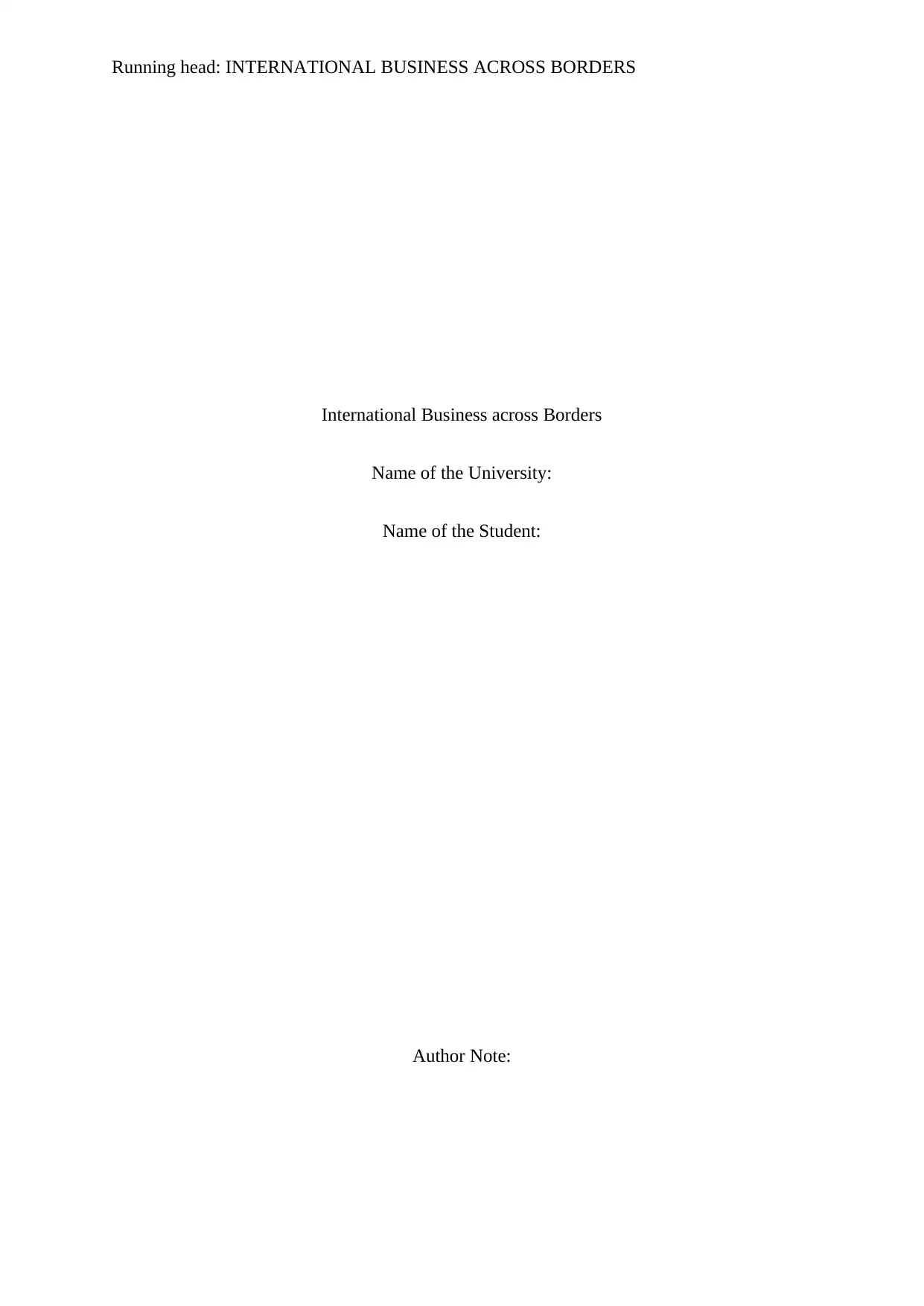
Running head: INTERNATIONAL BUSINESS ACROSS BORDERS
International Business across Borders
Name of the University:
Name of the Student:
Author Note:
International Business across Borders
Name of the University:
Name of the Student:
Author Note:
Paraphrase This Document
Need a fresh take? Get an instant paraphrase of this document with our AI Paraphraser
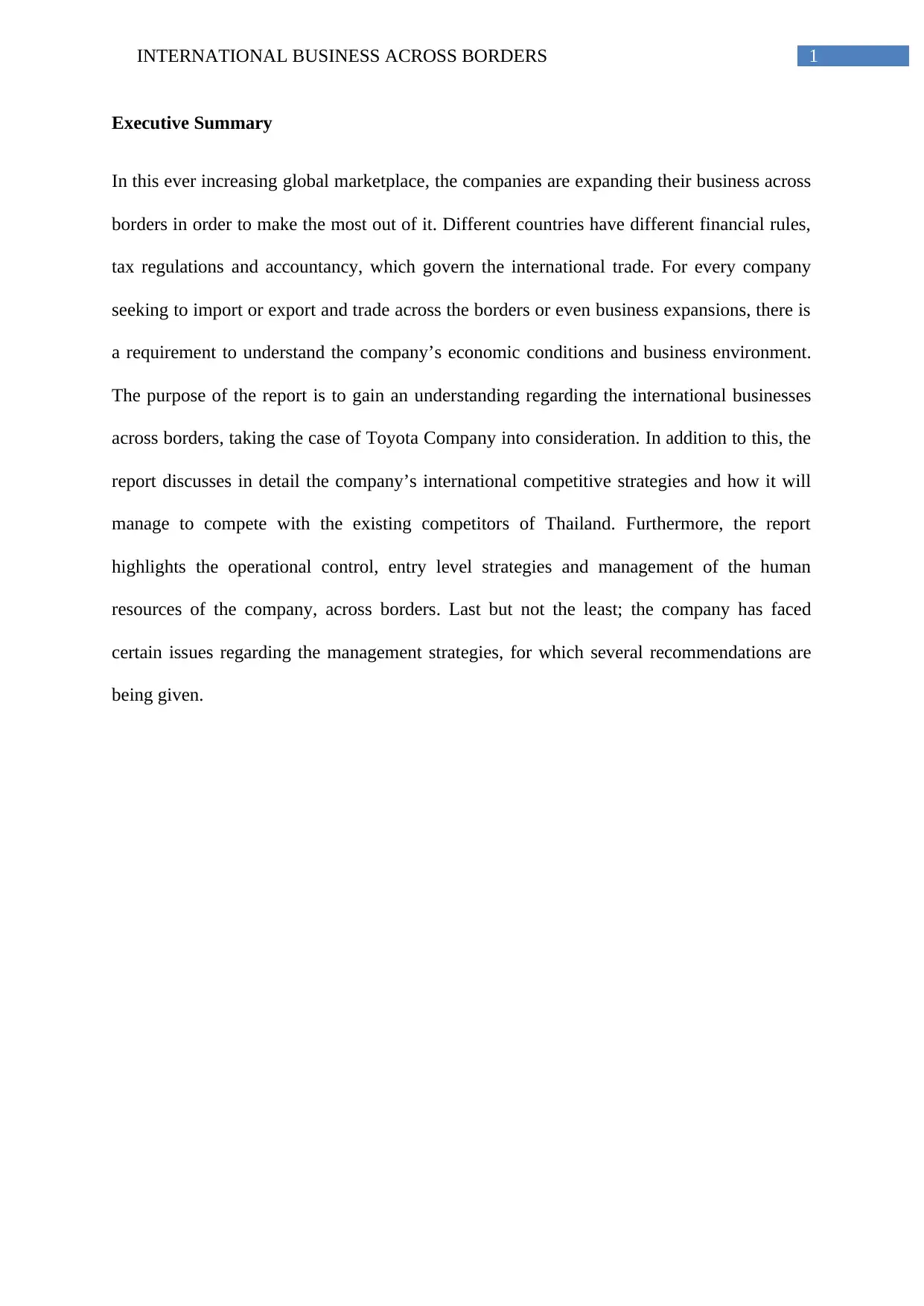
1INTERNATIONAL BUSINESS ACROSS BORDERS
Executive Summary
In this ever increasing global marketplace, the companies are expanding their business across
borders in order to make the most out of it. Different countries have different financial rules,
tax regulations and accountancy, which govern the international trade. For every company
seeking to import or export and trade across the borders or even business expansions, there is
a requirement to understand the company’s economic conditions and business environment.
The purpose of the report is to gain an understanding regarding the international businesses
across borders, taking the case of Toyota Company into consideration. In addition to this, the
report discusses in detail the company’s international competitive strategies and how it will
manage to compete with the existing competitors of Thailand. Furthermore, the report
highlights the operational control, entry level strategies and management of the human
resources of the company, across borders. Last but not the least; the company has faced
certain issues regarding the management strategies, for which several recommendations are
being given.
Executive Summary
In this ever increasing global marketplace, the companies are expanding their business across
borders in order to make the most out of it. Different countries have different financial rules,
tax regulations and accountancy, which govern the international trade. For every company
seeking to import or export and trade across the borders or even business expansions, there is
a requirement to understand the company’s economic conditions and business environment.
The purpose of the report is to gain an understanding regarding the international businesses
across borders, taking the case of Toyota Company into consideration. In addition to this, the
report discusses in detail the company’s international competitive strategies and how it will
manage to compete with the existing competitors of Thailand. Furthermore, the report
highlights the operational control, entry level strategies and management of the human
resources of the company, across borders. Last but not the least; the company has faced
certain issues regarding the management strategies, for which several recommendations are
being given.
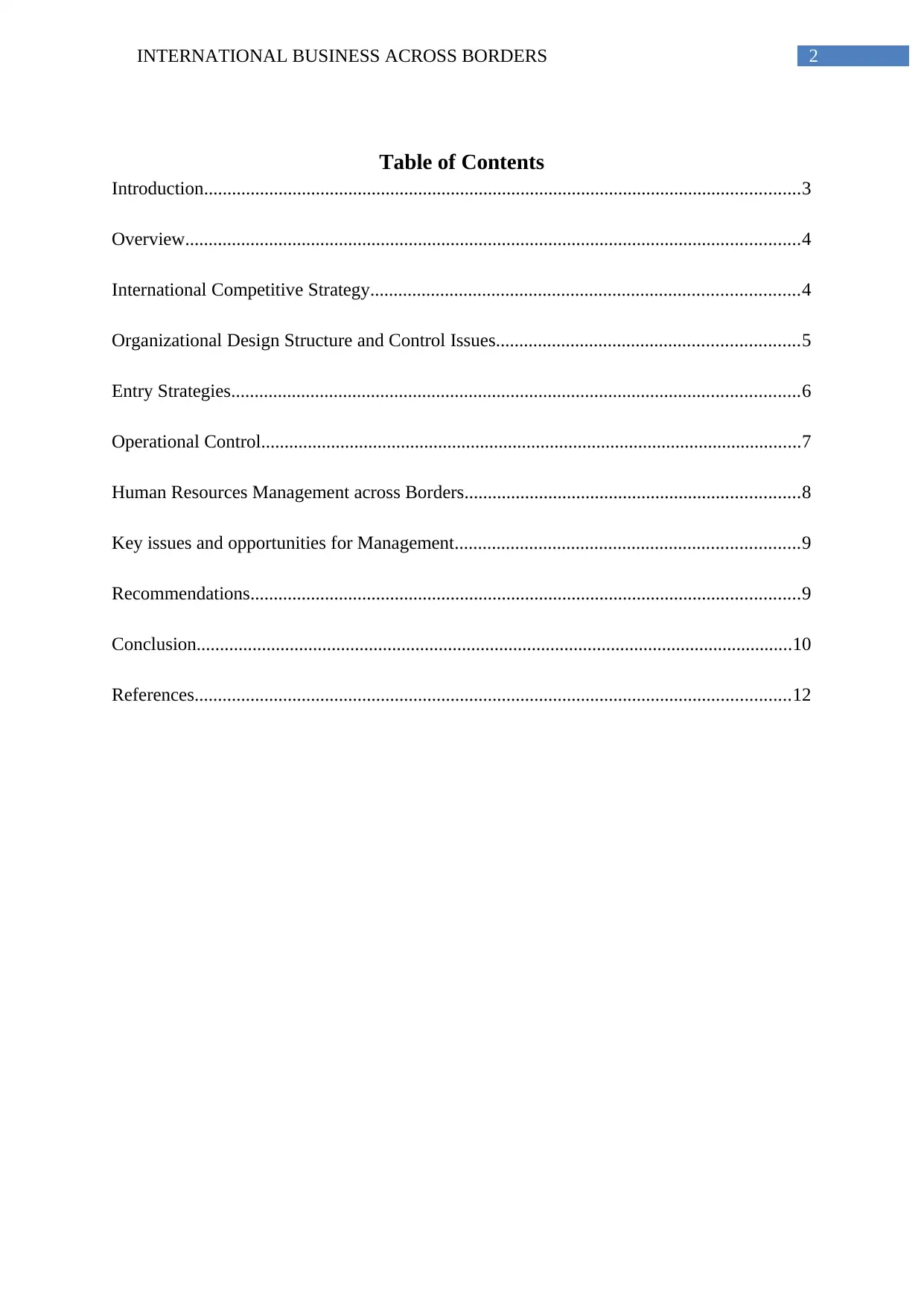
2INTERNATIONAL BUSINESS ACROSS BORDERS
Table of Contents
Introduction................................................................................................................................3
Overview....................................................................................................................................4
International Competitive Strategy............................................................................................4
Organizational Design Structure and Control Issues.................................................................5
Entry Strategies..........................................................................................................................6
Operational Control....................................................................................................................7
Human Resources Management across Borders........................................................................8
Key issues and opportunities for Management..........................................................................9
Recommendations......................................................................................................................9
Conclusion................................................................................................................................10
References................................................................................................................................12
Table of Contents
Introduction................................................................................................................................3
Overview....................................................................................................................................4
International Competitive Strategy............................................................................................4
Organizational Design Structure and Control Issues.................................................................5
Entry Strategies..........................................................................................................................6
Operational Control....................................................................................................................7
Human Resources Management across Borders........................................................................8
Key issues and opportunities for Management..........................................................................9
Recommendations......................................................................................................................9
Conclusion................................................................................................................................10
References................................................................................................................................12
⊘ This is a preview!⊘
Do you want full access?
Subscribe today to unlock all pages.

Trusted by 1+ million students worldwide
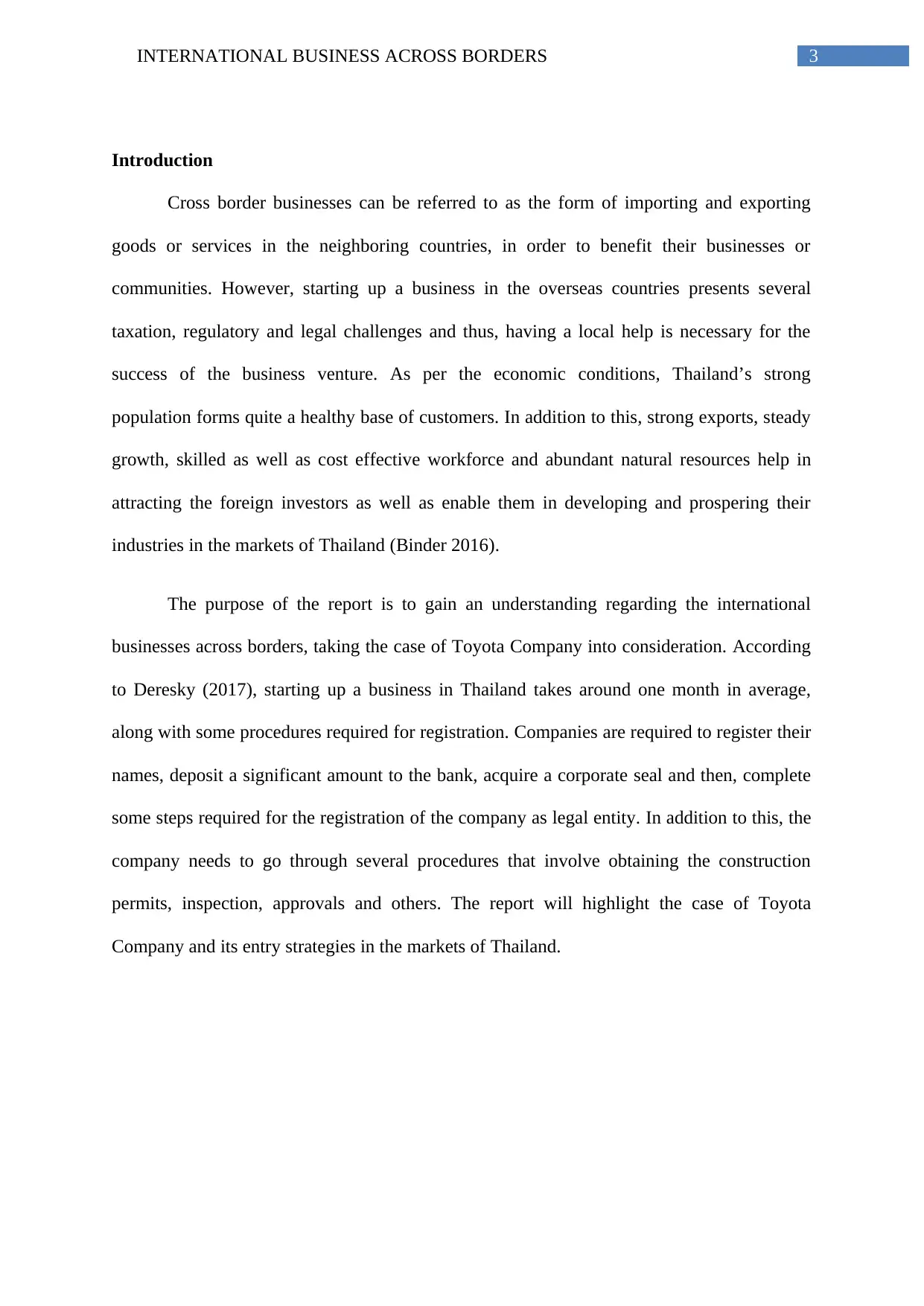
3INTERNATIONAL BUSINESS ACROSS BORDERS
Introduction
Cross border businesses can be referred to as the form of importing and exporting
goods or services in the neighboring countries, in order to benefit their businesses or
communities. However, starting up a business in the overseas countries presents several
taxation, regulatory and legal challenges and thus, having a local help is necessary for the
success of the business venture. As per the economic conditions, Thailand’s strong
population forms quite a healthy base of customers. In addition to this, strong exports, steady
growth, skilled as well as cost effective workforce and abundant natural resources help in
attracting the foreign investors as well as enable them in developing and prospering their
industries in the markets of Thailand (Binder 2016).
The purpose of the report is to gain an understanding regarding the international
businesses across borders, taking the case of Toyota Company into consideration. According
to Deresky (2017), starting up a business in Thailand takes around one month in average,
along with some procedures required for registration. Companies are required to register their
names, deposit a significant amount to the bank, acquire a corporate seal and then, complete
some steps required for the registration of the company as legal entity. In addition to this, the
company needs to go through several procedures that involve obtaining the construction
permits, inspection, approvals and others. The report will highlight the case of Toyota
Company and its entry strategies in the markets of Thailand.
Introduction
Cross border businesses can be referred to as the form of importing and exporting
goods or services in the neighboring countries, in order to benefit their businesses or
communities. However, starting up a business in the overseas countries presents several
taxation, regulatory and legal challenges and thus, having a local help is necessary for the
success of the business venture. As per the economic conditions, Thailand’s strong
population forms quite a healthy base of customers. In addition to this, strong exports, steady
growth, skilled as well as cost effective workforce and abundant natural resources help in
attracting the foreign investors as well as enable them in developing and prospering their
industries in the markets of Thailand (Binder 2016).
The purpose of the report is to gain an understanding regarding the international
businesses across borders, taking the case of Toyota Company into consideration. According
to Deresky (2017), starting up a business in Thailand takes around one month in average,
along with some procedures required for registration. Companies are required to register their
names, deposit a significant amount to the bank, acquire a corporate seal and then, complete
some steps required for the registration of the company as legal entity. In addition to this, the
company needs to go through several procedures that involve obtaining the construction
permits, inspection, approvals and others. The report will highlight the case of Toyota
Company and its entry strategies in the markets of Thailand.
Paraphrase This Document
Need a fresh take? Get an instant paraphrase of this document with our AI Paraphraser
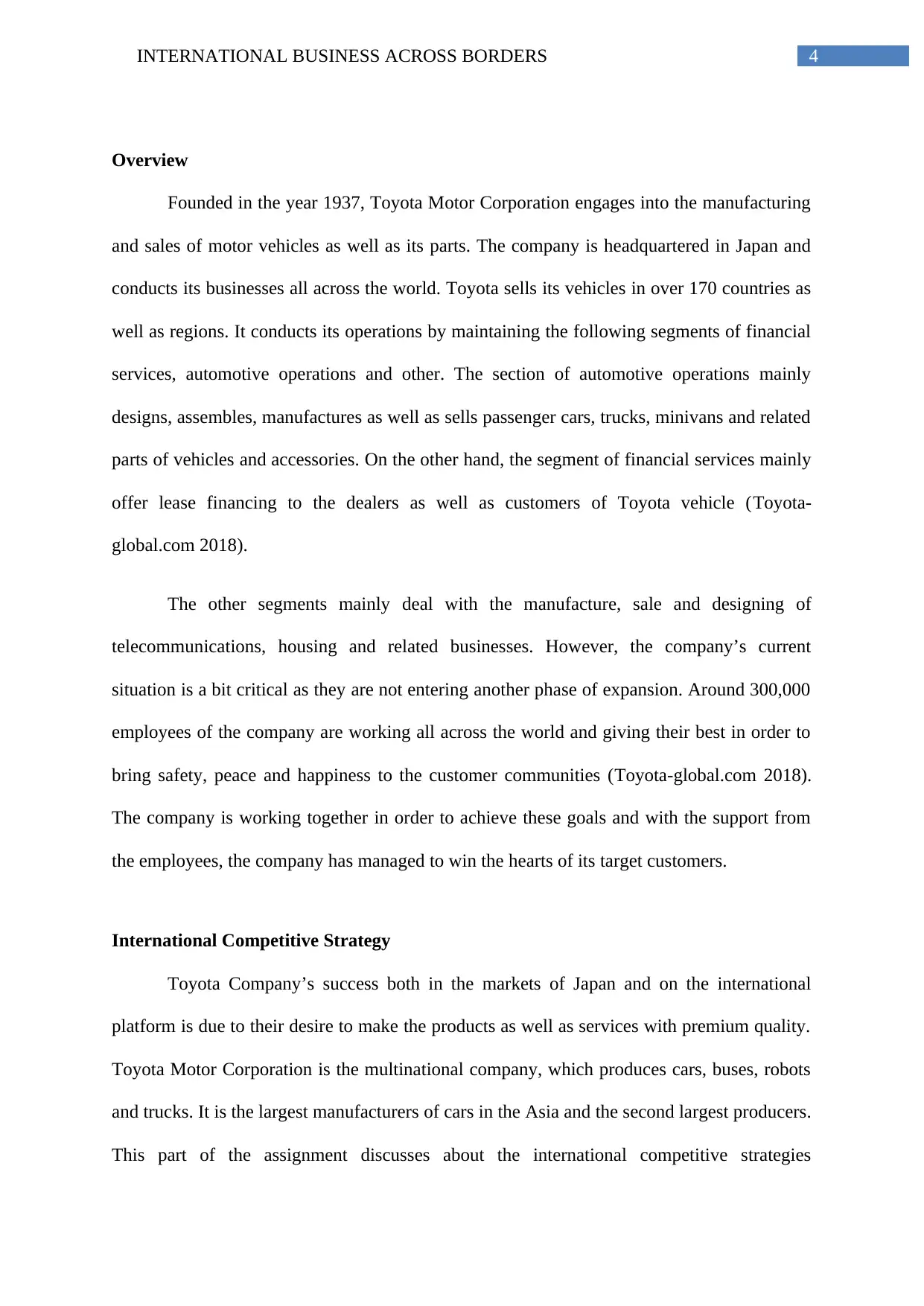
4INTERNATIONAL BUSINESS ACROSS BORDERS
Overview
Founded in the year 1937, Toyota Motor Corporation engages into the manufacturing
and sales of motor vehicles as well as its parts. The company is headquartered in Japan and
conducts its businesses all across the world. Toyota sells its vehicles in over 170 countries as
well as regions. It conducts its operations by maintaining the following segments of financial
services, automotive operations and other. The section of automotive operations mainly
designs, assembles, manufactures as well as sells passenger cars, trucks, minivans and related
parts of vehicles and accessories. On the other hand, the segment of financial services mainly
offer lease financing to the dealers as well as customers of Toyota vehicle (Toyota-
global.com 2018).
The other segments mainly deal with the manufacture, sale and designing of
telecommunications, housing and related businesses. However, the company’s current
situation is a bit critical as they are not entering another phase of expansion. Around 300,000
employees of the company are working all across the world and giving their best in order to
bring safety, peace and happiness to the customer communities (Toyota-global.com 2018).
The company is working together in order to achieve these goals and with the support from
the employees, the company has managed to win the hearts of its target customers.
International Competitive Strategy
Toyota Company’s success both in the markets of Japan and on the international
platform is due to their desire to make the products as well as services with premium quality.
Toyota Motor Corporation is the multinational company, which produces cars, buses, robots
and trucks. It is the largest manufacturers of cars in the Asia and the second largest producers.
This part of the assignment discusses about the international competitive strategies
Overview
Founded in the year 1937, Toyota Motor Corporation engages into the manufacturing
and sales of motor vehicles as well as its parts. The company is headquartered in Japan and
conducts its businesses all across the world. Toyota sells its vehicles in over 170 countries as
well as regions. It conducts its operations by maintaining the following segments of financial
services, automotive operations and other. The section of automotive operations mainly
designs, assembles, manufactures as well as sells passenger cars, trucks, minivans and related
parts of vehicles and accessories. On the other hand, the segment of financial services mainly
offer lease financing to the dealers as well as customers of Toyota vehicle (Toyota-
global.com 2018).
The other segments mainly deal with the manufacture, sale and designing of
telecommunications, housing and related businesses. However, the company’s current
situation is a bit critical as they are not entering another phase of expansion. Around 300,000
employees of the company are working all across the world and giving their best in order to
bring safety, peace and happiness to the customer communities (Toyota-global.com 2018).
The company is working together in order to achieve these goals and with the support from
the employees, the company has managed to win the hearts of its target customers.
International Competitive Strategy
Toyota Company’s success both in the markets of Japan and on the international
platform is due to their desire to make the products as well as services with premium quality.
Toyota Motor Corporation is the multinational company, which produces cars, buses, robots
and trucks. It is the largest manufacturers of cars in the Asia and the second largest producers.
This part of the assignment discusses about the international competitive strategies
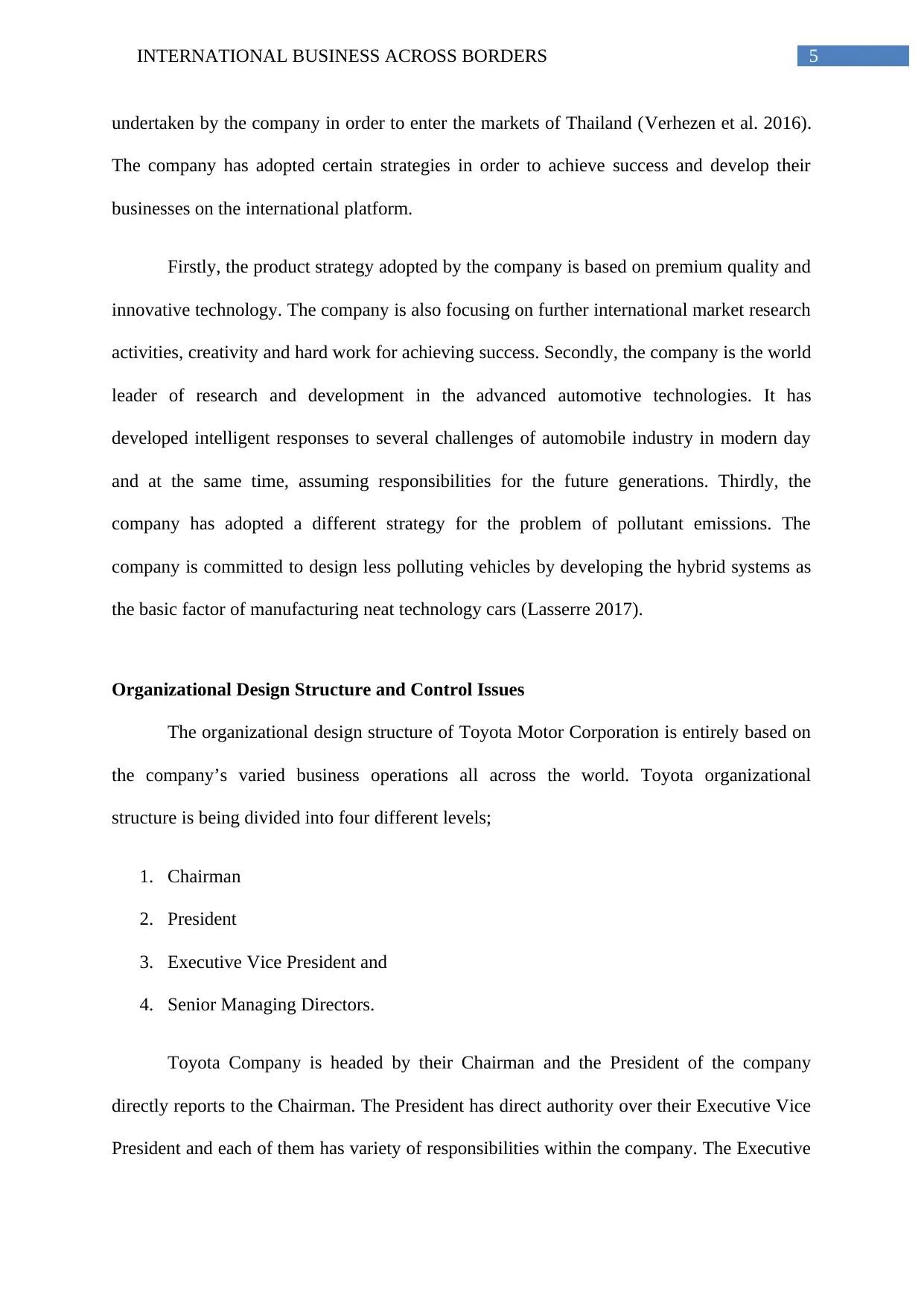
5INTERNATIONAL BUSINESS ACROSS BORDERS
undertaken by the company in order to enter the markets of Thailand (Verhezen et al. 2016).
The company has adopted certain strategies in order to achieve success and develop their
businesses on the international platform.
Firstly, the product strategy adopted by the company is based on premium quality and
innovative technology. The company is also focusing on further international market research
activities, creativity and hard work for achieving success. Secondly, the company is the world
leader of research and development in the advanced automotive technologies. It has
developed intelligent responses to several challenges of automobile industry in modern day
and at the same time, assuming responsibilities for the future generations. Thirdly, the
company has adopted a different strategy for the problem of pollutant emissions. The
company is committed to design less polluting vehicles by developing the hybrid systems as
the basic factor of manufacturing neat technology cars (Lasserre 2017).
Organizational Design Structure and Control Issues
The organizational design structure of Toyota Motor Corporation is entirely based on
the company’s varied business operations all across the world. Toyota organizational
structure is being divided into four different levels;
1. Chairman
2. President
3. Executive Vice President and
4. Senior Managing Directors.
Toyota Company is headed by their Chairman and the President of the company
directly reports to the Chairman. The President has direct authority over their Executive Vice
President and each of them has variety of responsibilities within the company. The Executive
undertaken by the company in order to enter the markets of Thailand (Verhezen et al. 2016).
The company has adopted certain strategies in order to achieve success and develop their
businesses on the international platform.
Firstly, the product strategy adopted by the company is based on premium quality and
innovative technology. The company is also focusing on further international market research
activities, creativity and hard work for achieving success. Secondly, the company is the world
leader of research and development in the advanced automotive technologies. It has
developed intelligent responses to several challenges of automobile industry in modern day
and at the same time, assuming responsibilities for the future generations. Thirdly, the
company has adopted a different strategy for the problem of pollutant emissions. The
company is committed to design less polluting vehicles by developing the hybrid systems as
the basic factor of manufacturing neat technology cars (Lasserre 2017).
Organizational Design Structure and Control Issues
The organizational design structure of Toyota Motor Corporation is entirely based on
the company’s varied business operations all across the world. Toyota organizational
structure is being divided into four different levels;
1. Chairman
2. President
3. Executive Vice President and
4. Senior Managing Directors.
Toyota Company is headed by their Chairman and the President of the company
directly reports to the Chairman. The President has direct authority over their Executive Vice
President and each of them has variety of responsibilities within the company. The Executive
⊘ This is a preview!⊘
Do you want full access?
Subscribe today to unlock all pages.

Trusted by 1+ million students worldwide
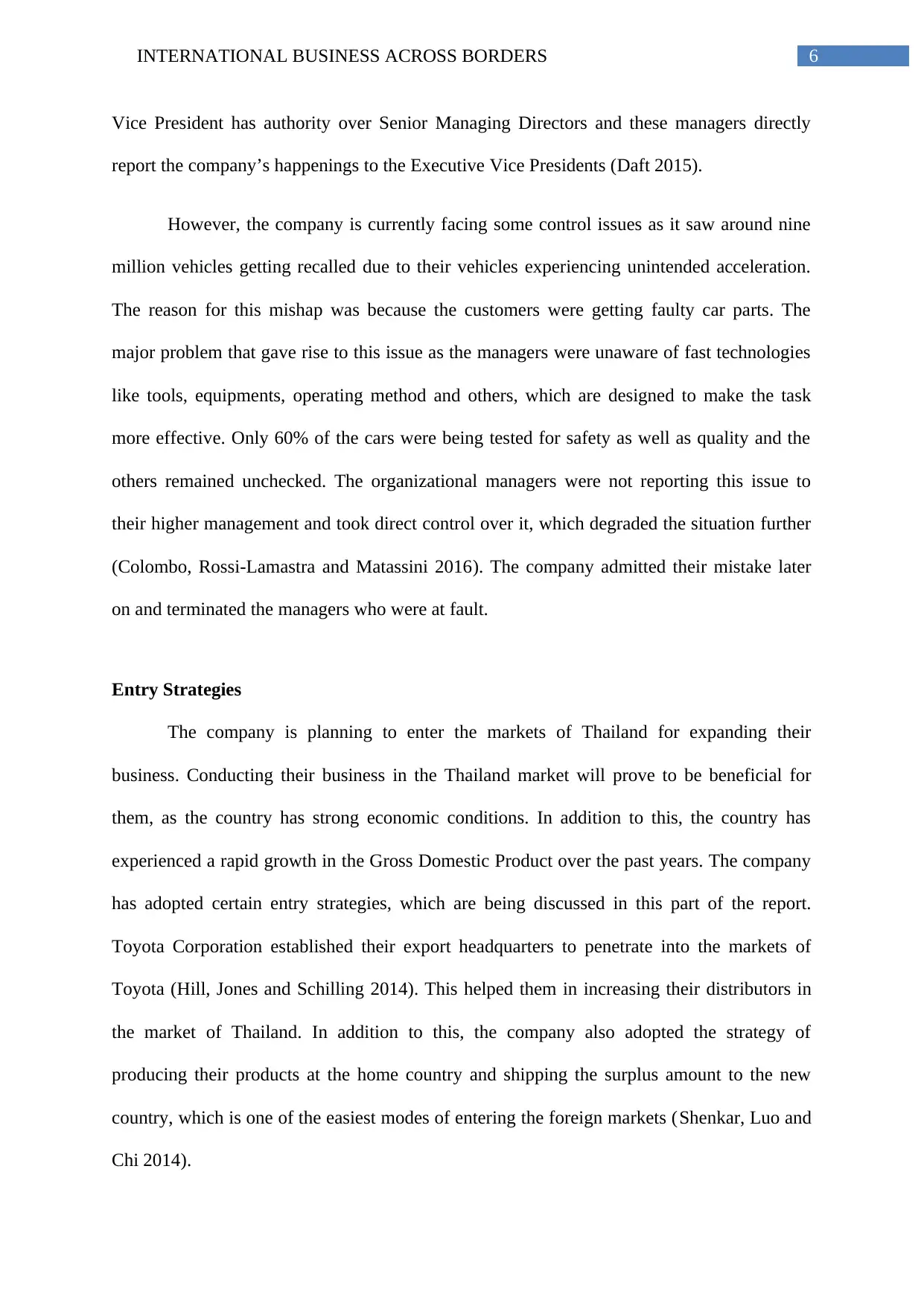
6INTERNATIONAL BUSINESS ACROSS BORDERS
Vice President has authority over Senior Managing Directors and these managers directly
report the company’s happenings to the Executive Vice Presidents (Daft 2015).
However, the company is currently facing some control issues as it saw around nine
million vehicles getting recalled due to their vehicles experiencing unintended acceleration.
The reason for this mishap was because the customers were getting faulty car parts. The
major problem that gave rise to this issue as the managers were unaware of fast technologies
like tools, equipments, operating method and others, which are designed to make the task
more effective. Only 60% of the cars were being tested for safety as well as quality and the
others remained unchecked. The organizational managers were not reporting this issue to
their higher management and took direct control over it, which degraded the situation further
(Colombo, Rossi-Lamastra and Matassini 2016). The company admitted their mistake later
on and terminated the managers who were at fault.
Entry Strategies
The company is planning to enter the markets of Thailand for expanding their
business. Conducting their business in the Thailand market will prove to be beneficial for
them, as the country has strong economic conditions. In addition to this, the country has
experienced a rapid growth in the Gross Domestic Product over the past years. The company
has adopted certain entry strategies, which are being discussed in this part of the report.
Toyota Corporation established their export headquarters to penetrate into the markets of
Toyota (Hill, Jones and Schilling 2014). This helped them in increasing their distributors in
the market of Thailand. In addition to this, the company also adopted the strategy of
producing their products at the home country and shipping the surplus amount to the new
country, which is one of the easiest modes of entering the foreign markets (Shenkar, Luo and
Chi 2014).
Vice President has authority over Senior Managing Directors and these managers directly
report the company’s happenings to the Executive Vice Presidents (Daft 2015).
However, the company is currently facing some control issues as it saw around nine
million vehicles getting recalled due to their vehicles experiencing unintended acceleration.
The reason for this mishap was because the customers were getting faulty car parts. The
major problem that gave rise to this issue as the managers were unaware of fast technologies
like tools, equipments, operating method and others, which are designed to make the task
more effective. Only 60% of the cars were being tested for safety as well as quality and the
others remained unchecked. The organizational managers were not reporting this issue to
their higher management and took direct control over it, which degraded the situation further
(Colombo, Rossi-Lamastra and Matassini 2016). The company admitted their mistake later
on and terminated the managers who were at fault.
Entry Strategies
The company is planning to enter the markets of Thailand for expanding their
business. Conducting their business in the Thailand market will prove to be beneficial for
them, as the country has strong economic conditions. In addition to this, the country has
experienced a rapid growth in the Gross Domestic Product over the past years. The company
has adopted certain entry strategies, which are being discussed in this part of the report.
Toyota Corporation established their export headquarters to penetrate into the markets of
Toyota (Hill, Jones and Schilling 2014). This helped them in increasing their distributors in
the market of Thailand. In addition to this, the company also adopted the strategy of
producing their products at the home country and shipping the surplus amount to the new
country, which is one of the easiest modes of entering the foreign markets (Shenkar, Luo and
Chi 2014).
Paraphrase This Document
Need a fresh take? Get an instant paraphrase of this document with our AI Paraphraser
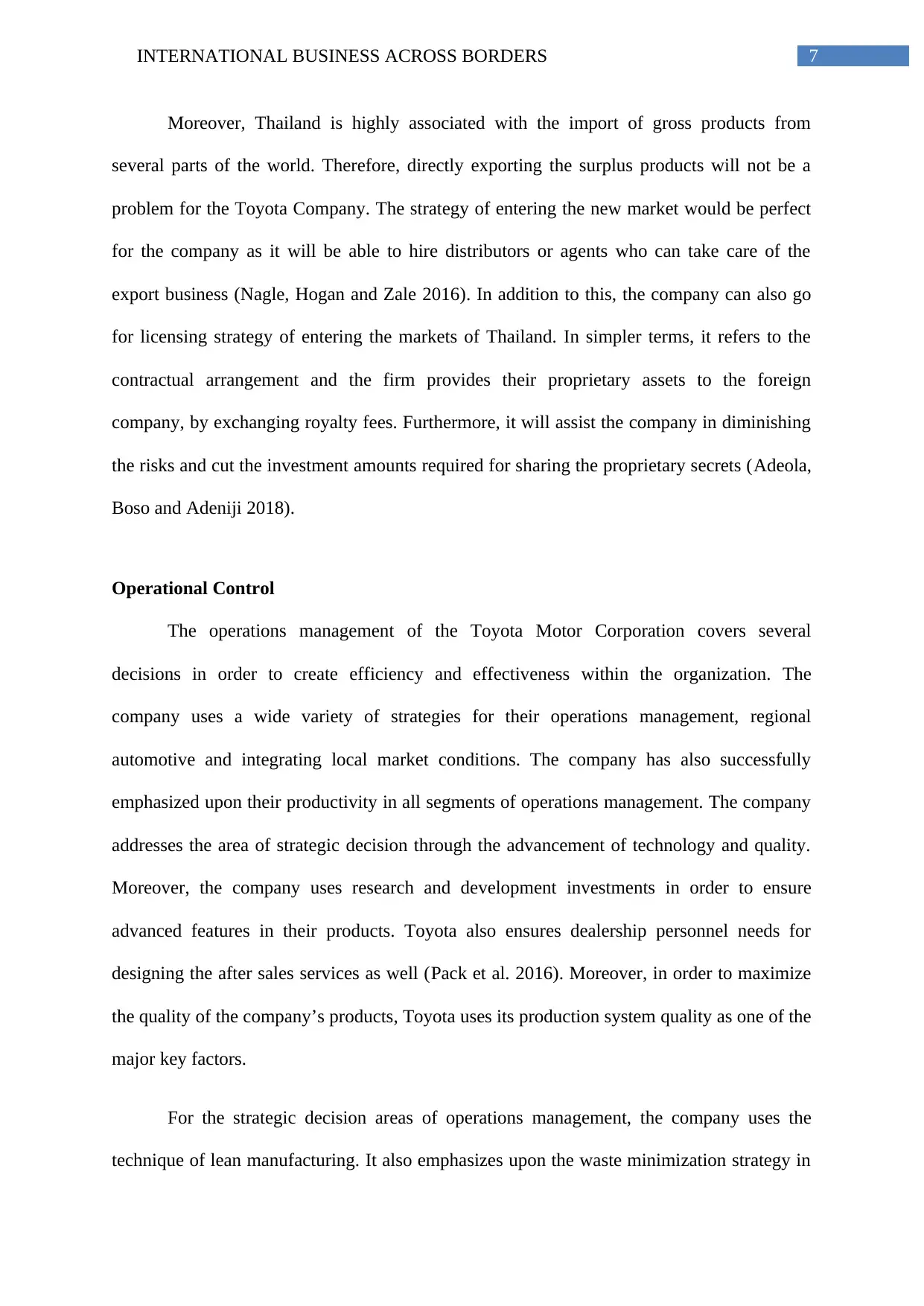
7INTERNATIONAL BUSINESS ACROSS BORDERS
Moreover, Thailand is highly associated with the import of gross products from
several parts of the world. Therefore, directly exporting the surplus products will not be a
problem for the Toyota Company. The strategy of entering the new market would be perfect
for the company as it will be able to hire distributors or agents who can take care of the
export business (Nagle, Hogan and Zale 2016). In addition to this, the company can also go
for licensing strategy of entering the markets of Thailand. In simpler terms, it refers to the
contractual arrangement and the firm provides their proprietary assets to the foreign
company, by exchanging royalty fees. Furthermore, it will assist the company in diminishing
the risks and cut the investment amounts required for sharing the proprietary secrets (Adeola,
Boso and Adeniji 2018).
Operational Control
The operations management of the Toyota Motor Corporation covers several
decisions in order to create efficiency and effectiveness within the organization. The
company uses a wide variety of strategies for their operations management, regional
automotive and integrating local market conditions. The company has also successfully
emphasized upon their productivity in all segments of operations management. The company
addresses the area of strategic decision through the advancement of technology and quality.
Moreover, the company uses research and development investments in order to ensure
advanced features in their products. Toyota also ensures dealership personnel needs for
designing the after sales services as well (Pack et al. 2016). Moreover, in order to maximize
the quality of the company’s products, Toyota uses its production system quality as one of the
major key factors.
For the strategic decision areas of operations management, the company uses the
technique of lean manufacturing. It also emphasizes upon the waste minimization strategy in
Moreover, Thailand is highly associated with the import of gross products from
several parts of the world. Therefore, directly exporting the surplus products will not be a
problem for the Toyota Company. The strategy of entering the new market would be perfect
for the company as it will be able to hire distributors or agents who can take care of the
export business (Nagle, Hogan and Zale 2016). In addition to this, the company can also go
for licensing strategy of entering the markets of Thailand. In simpler terms, it refers to the
contractual arrangement and the firm provides their proprietary assets to the foreign
company, by exchanging royalty fees. Furthermore, it will assist the company in diminishing
the risks and cut the investment amounts required for sharing the proprietary secrets (Adeola,
Boso and Adeniji 2018).
Operational Control
The operations management of the Toyota Motor Corporation covers several
decisions in order to create efficiency and effectiveness within the organization. The
company uses a wide variety of strategies for their operations management, regional
automotive and integrating local market conditions. The company has also successfully
emphasized upon their productivity in all segments of operations management. The company
addresses the area of strategic decision through the advancement of technology and quality.
Moreover, the company uses research and development investments in order to ensure
advanced features in their products. Toyota also ensures dealership personnel needs for
designing the after sales services as well (Pack et al. 2016). Moreover, in order to maximize
the quality of the company’s products, Toyota uses its production system quality as one of the
major key factors.
For the strategic decision areas of operations management, the company uses the
technique of lean manufacturing. It also emphasizes upon the waste minimization strategy in
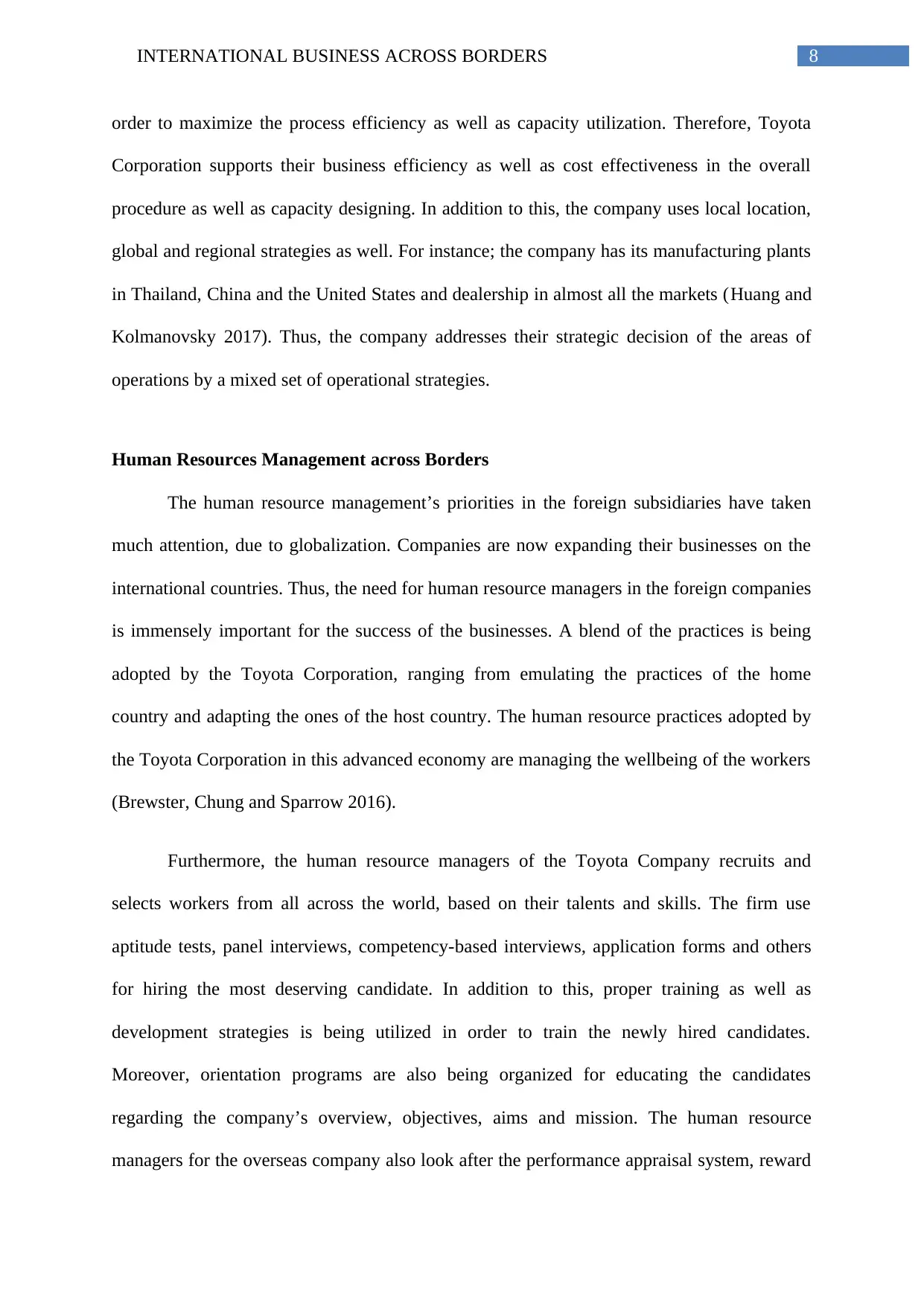
8INTERNATIONAL BUSINESS ACROSS BORDERS
order to maximize the process efficiency as well as capacity utilization. Therefore, Toyota
Corporation supports their business efficiency as well as cost effectiveness in the overall
procedure as well as capacity designing. In addition to this, the company uses local location,
global and regional strategies as well. For instance; the company has its manufacturing plants
in Thailand, China and the United States and dealership in almost all the markets (Huang and
Kolmanovsky 2017). Thus, the company addresses their strategic decision of the areas of
operations by a mixed set of operational strategies.
Human Resources Management across Borders
The human resource management’s priorities in the foreign subsidiaries have taken
much attention, due to globalization. Companies are now expanding their businesses on the
international countries. Thus, the need for human resource managers in the foreign companies
is immensely important for the success of the businesses. A blend of the practices is being
adopted by the Toyota Corporation, ranging from emulating the practices of the home
country and adapting the ones of the host country. The human resource practices adopted by
the Toyota Corporation in this advanced economy are managing the wellbeing of the workers
(Brewster, Chung and Sparrow 2016).
Furthermore, the human resource managers of the Toyota Company recruits and
selects workers from all across the world, based on their talents and skills. The firm use
aptitude tests, panel interviews, competency-based interviews, application forms and others
for hiring the most deserving candidate. In addition to this, proper training as well as
development strategies is being utilized in order to train the newly hired candidates.
Moreover, orientation programs are also being organized for educating the candidates
regarding the company’s overview, objectives, aims and mission. The human resource
managers for the overseas company also look after the performance appraisal system, reward
order to maximize the process efficiency as well as capacity utilization. Therefore, Toyota
Corporation supports their business efficiency as well as cost effectiveness in the overall
procedure as well as capacity designing. In addition to this, the company uses local location,
global and regional strategies as well. For instance; the company has its manufacturing plants
in Thailand, China and the United States and dealership in almost all the markets (Huang and
Kolmanovsky 2017). Thus, the company addresses their strategic decision of the areas of
operations by a mixed set of operational strategies.
Human Resources Management across Borders
The human resource management’s priorities in the foreign subsidiaries have taken
much attention, due to globalization. Companies are now expanding their businesses on the
international countries. Thus, the need for human resource managers in the foreign companies
is immensely important for the success of the businesses. A blend of the practices is being
adopted by the Toyota Corporation, ranging from emulating the practices of the home
country and adapting the ones of the host country. The human resource practices adopted by
the Toyota Corporation in this advanced economy are managing the wellbeing of the workers
(Brewster, Chung and Sparrow 2016).
Furthermore, the human resource managers of the Toyota Company recruits and
selects workers from all across the world, based on their talents and skills. The firm use
aptitude tests, panel interviews, competency-based interviews, application forms and others
for hiring the most deserving candidate. In addition to this, proper training as well as
development strategies is being utilized in order to train the newly hired candidates.
Moreover, orientation programs are also being organized for educating the candidates
regarding the company’s overview, objectives, aims and mission. The human resource
managers for the overseas company also look after the performance appraisal system, reward
⊘ This is a preview!⊘
Do you want full access?
Subscribe today to unlock all pages.

Trusted by 1+ million students worldwide
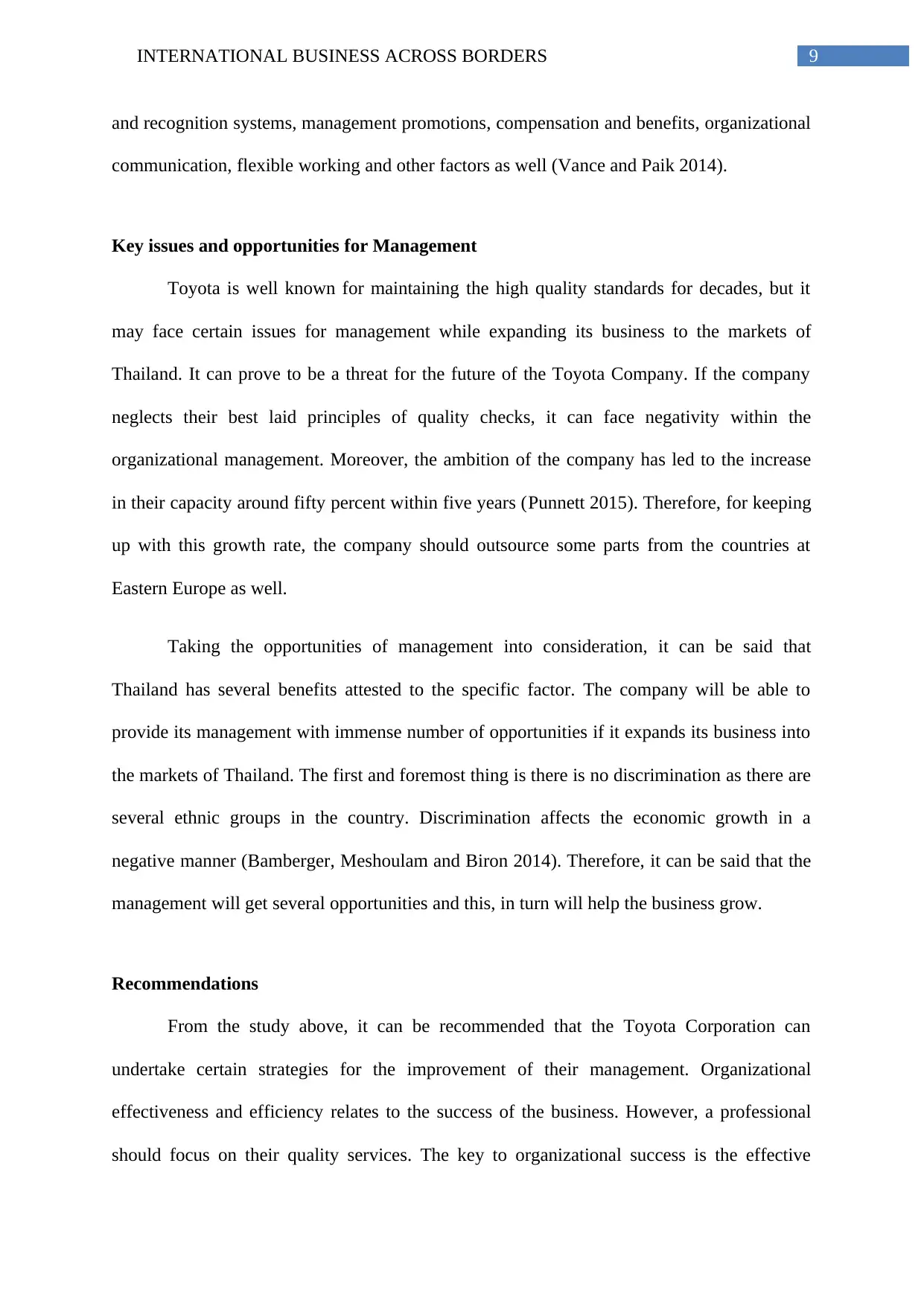
9INTERNATIONAL BUSINESS ACROSS BORDERS
and recognition systems, management promotions, compensation and benefits, organizational
communication, flexible working and other factors as well (Vance and Paik 2014).
Key issues and opportunities for Management
Toyota is well known for maintaining the high quality standards for decades, but it
may face certain issues for management while expanding its business to the markets of
Thailand. It can prove to be a threat for the future of the Toyota Company. If the company
neglects their best laid principles of quality checks, it can face negativity within the
organizational management. Moreover, the ambition of the company has led to the increase
in their capacity around fifty percent within five years (Punnett 2015). Therefore, for keeping
up with this growth rate, the company should outsource some parts from the countries at
Eastern Europe as well.
Taking the opportunities of management into consideration, it can be said that
Thailand has several benefits attested to the specific factor. The company will be able to
provide its management with immense number of opportunities if it expands its business into
the markets of Thailand. The first and foremost thing is there is no discrimination as there are
several ethnic groups in the country. Discrimination affects the economic growth in a
negative manner (Bamberger, Meshoulam and Biron 2014). Therefore, it can be said that the
management will get several opportunities and this, in turn will help the business grow.
Recommendations
From the study above, it can be recommended that the Toyota Corporation can
undertake certain strategies for the improvement of their management. Organizational
effectiveness and efficiency relates to the success of the business. However, a professional
should focus on their quality services. The key to organizational success is the effective
and recognition systems, management promotions, compensation and benefits, organizational
communication, flexible working and other factors as well (Vance and Paik 2014).
Key issues and opportunities for Management
Toyota is well known for maintaining the high quality standards for decades, but it
may face certain issues for management while expanding its business to the markets of
Thailand. It can prove to be a threat for the future of the Toyota Company. If the company
neglects their best laid principles of quality checks, it can face negativity within the
organizational management. Moreover, the ambition of the company has led to the increase
in their capacity around fifty percent within five years (Punnett 2015). Therefore, for keeping
up with this growth rate, the company should outsource some parts from the countries at
Eastern Europe as well.
Taking the opportunities of management into consideration, it can be said that
Thailand has several benefits attested to the specific factor. The company will be able to
provide its management with immense number of opportunities if it expands its business into
the markets of Thailand. The first and foremost thing is there is no discrimination as there are
several ethnic groups in the country. Discrimination affects the economic growth in a
negative manner (Bamberger, Meshoulam and Biron 2014). Therefore, it can be said that the
management will get several opportunities and this, in turn will help the business grow.
Recommendations
From the study above, it can be recommended that the Toyota Corporation can
undertake certain strategies for the improvement of their management. Organizational
effectiveness and efficiency relates to the success of the business. However, a professional
should focus on their quality services. The key to organizational success is the effective
Paraphrase This Document
Need a fresh take? Get an instant paraphrase of this document with our AI Paraphraser
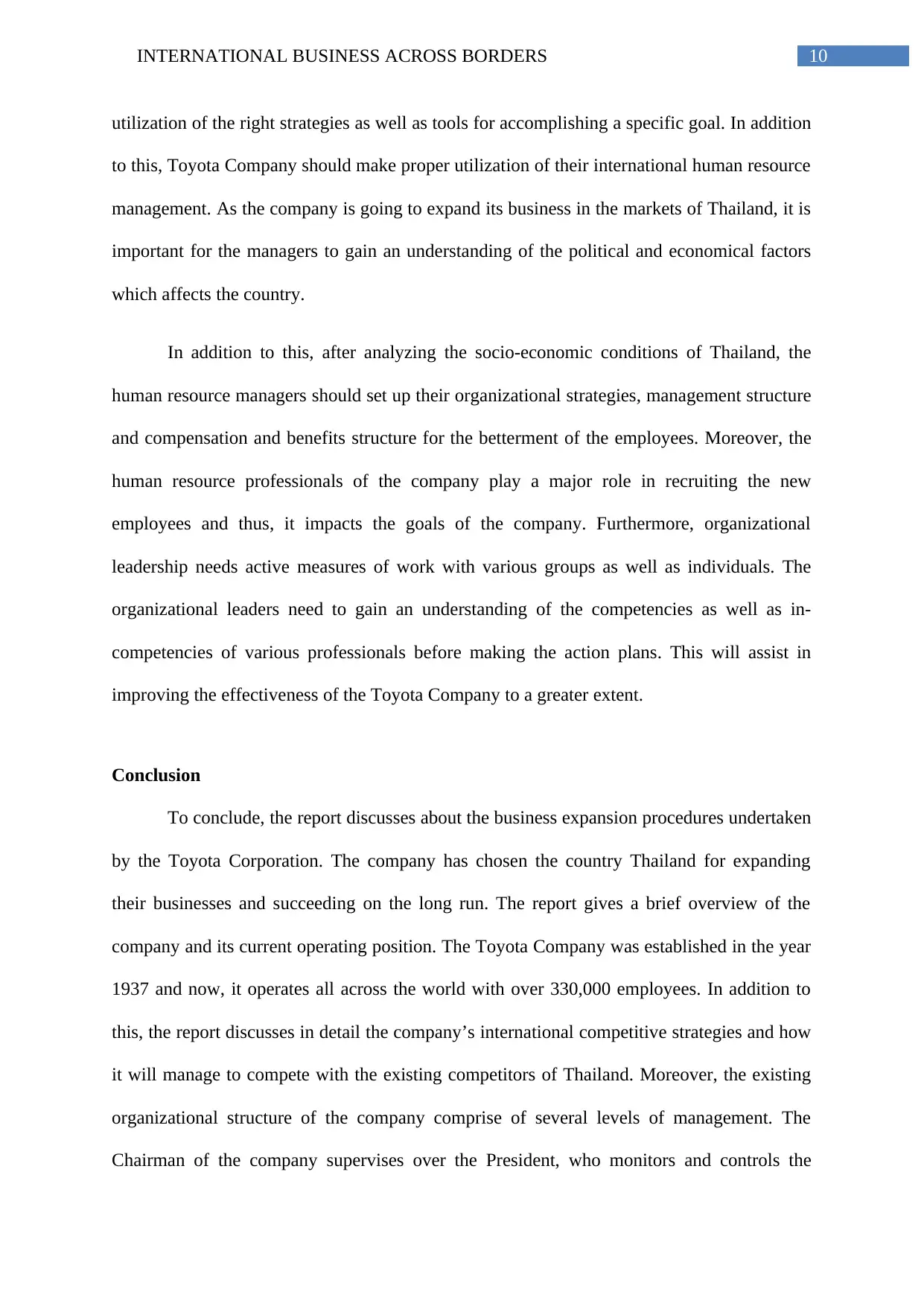
10INTERNATIONAL BUSINESS ACROSS BORDERS
utilization of the right strategies as well as tools for accomplishing a specific goal. In addition
to this, Toyota Company should make proper utilization of their international human resource
management. As the company is going to expand its business in the markets of Thailand, it is
important for the managers to gain an understanding of the political and economical factors
which affects the country.
In addition to this, after analyzing the socio-economic conditions of Thailand, the
human resource managers should set up their organizational strategies, management structure
and compensation and benefits structure for the betterment of the employees. Moreover, the
human resource professionals of the company play a major role in recruiting the new
employees and thus, it impacts the goals of the company. Furthermore, organizational
leadership needs active measures of work with various groups as well as individuals. The
organizational leaders need to gain an understanding of the competencies as well as in-
competencies of various professionals before making the action plans. This will assist in
improving the effectiveness of the Toyota Company to a greater extent.
Conclusion
To conclude, the report discusses about the business expansion procedures undertaken
by the Toyota Corporation. The company has chosen the country Thailand for expanding
their businesses and succeeding on the long run. The report gives a brief overview of the
company and its current operating position. The Toyota Company was established in the year
1937 and now, it operates all across the world with over 330,000 employees. In addition to
this, the report discusses in detail the company’s international competitive strategies and how
it will manage to compete with the existing competitors of Thailand. Moreover, the existing
organizational structure of the company comprise of several levels of management. The
Chairman of the company supervises over the President, who monitors and controls the
utilization of the right strategies as well as tools for accomplishing a specific goal. In addition
to this, Toyota Company should make proper utilization of their international human resource
management. As the company is going to expand its business in the markets of Thailand, it is
important for the managers to gain an understanding of the political and economical factors
which affects the country.
In addition to this, after analyzing the socio-economic conditions of Thailand, the
human resource managers should set up their organizational strategies, management structure
and compensation and benefits structure for the betterment of the employees. Moreover, the
human resource professionals of the company play a major role in recruiting the new
employees and thus, it impacts the goals of the company. Furthermore, organizational
leadership needs active measures of work with various groups as well as individuals. The
organizational leaders need to gain an understanding of the competencies as well as in-
competencies of various professionals before making the action plans. This will assist in
improving the effectiveness of the Toyota Company to a greater extent.
Conclusion
To conclude, the report discusses about the business expansion procedures undertaken
by the Toyota Corporation. The company has chosen the country Thailand for expanding
their businesses and succeeding on the long run. The report gives a brief overview of the
company and its current operating position. The Toyota Company was established in the year
1937 and now, it operates all across the world with over 330,000 employees. In addition to
this, the report discusses in detail the company’s international competitive strategies and how
it will manage to compete with the existing competitors of Thailand. Moreover, the existing
organizational structure of the company comprise of several levels of management. The
Chairman of the company supervises over the President, who monitors and controls the
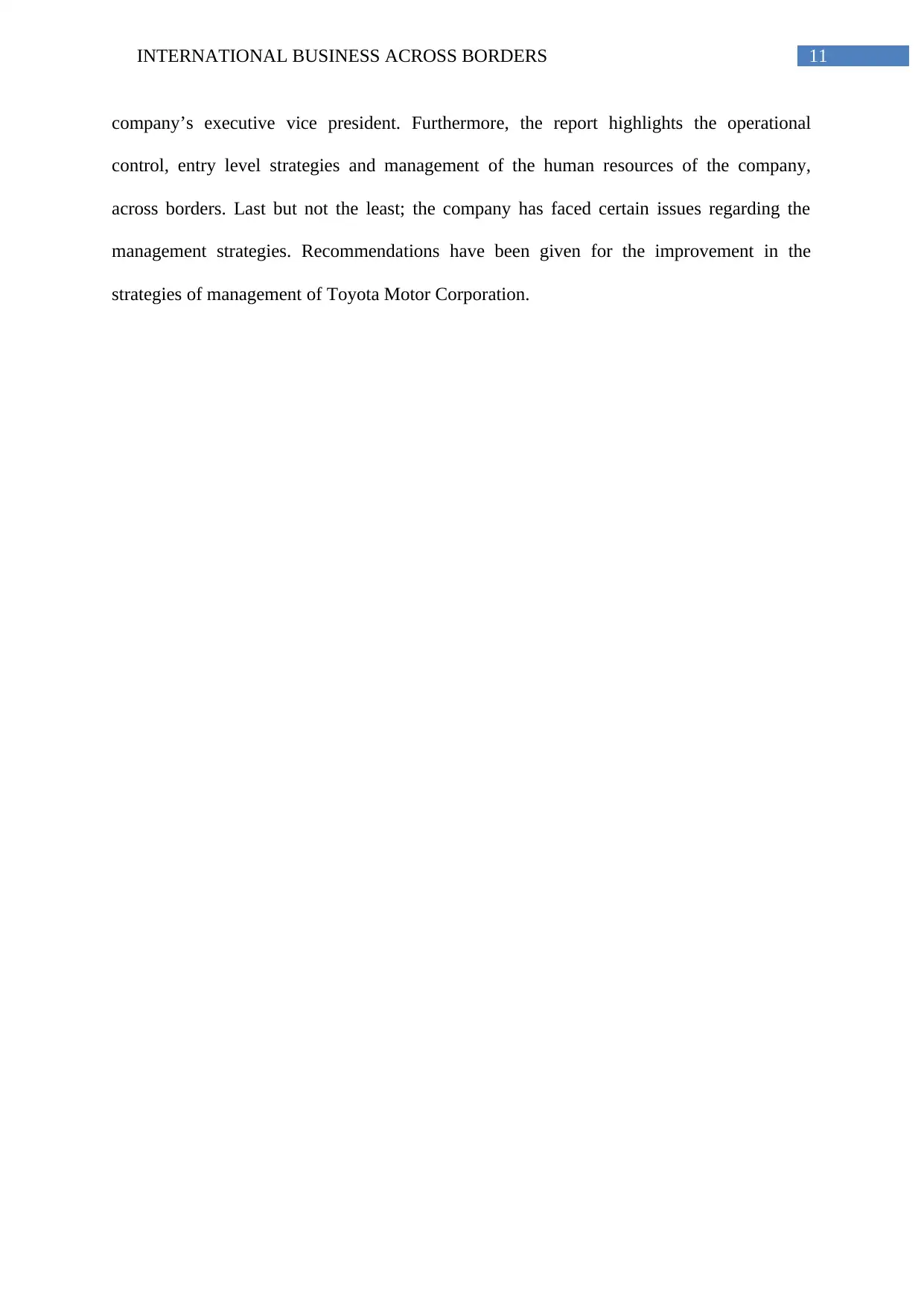
11INTERNATIONAL BUSINESS ACROSS BORDERS
company’s executive vice president. Furthermore, the report highlights the operational
control, entry level strategies and management of the human resources of the company,
across borders. Last but not the least; the company has faced certain issues regarding the
management strategies. Recommendations have been given for the improvement in the
strategies of management of Toyota Motor Corporation.
company’s executive vice president. Furthermore, the report highlights the operational
control, entry level strategies and management of the human resources of the company,
across borders. Last but not the least; the company has faced certain issues regarding the
management strategies. Recommendations have been given for the improvement in the
strategies of management of Toyota Motor Corporation.
⊘ This is a preview!⊘
Do you want full access?
Subscribe today to unlock all pages.

Trusted by 1+ million students worldwide
1 out of 14
Related Documents
Your All-in-One AI-Powered Toolkit for Academic Success.
+13062052269
info@desklib.com
Available 24*7 on WhatsApp / Email
![[object Object]](/_next/static/media/star-bottom.7253800d.svg)
Unlock your academic potential
Copyright © 2020–2025 A2Z Services. All Rights Reserved. Developed and managed by ZUCOL.





